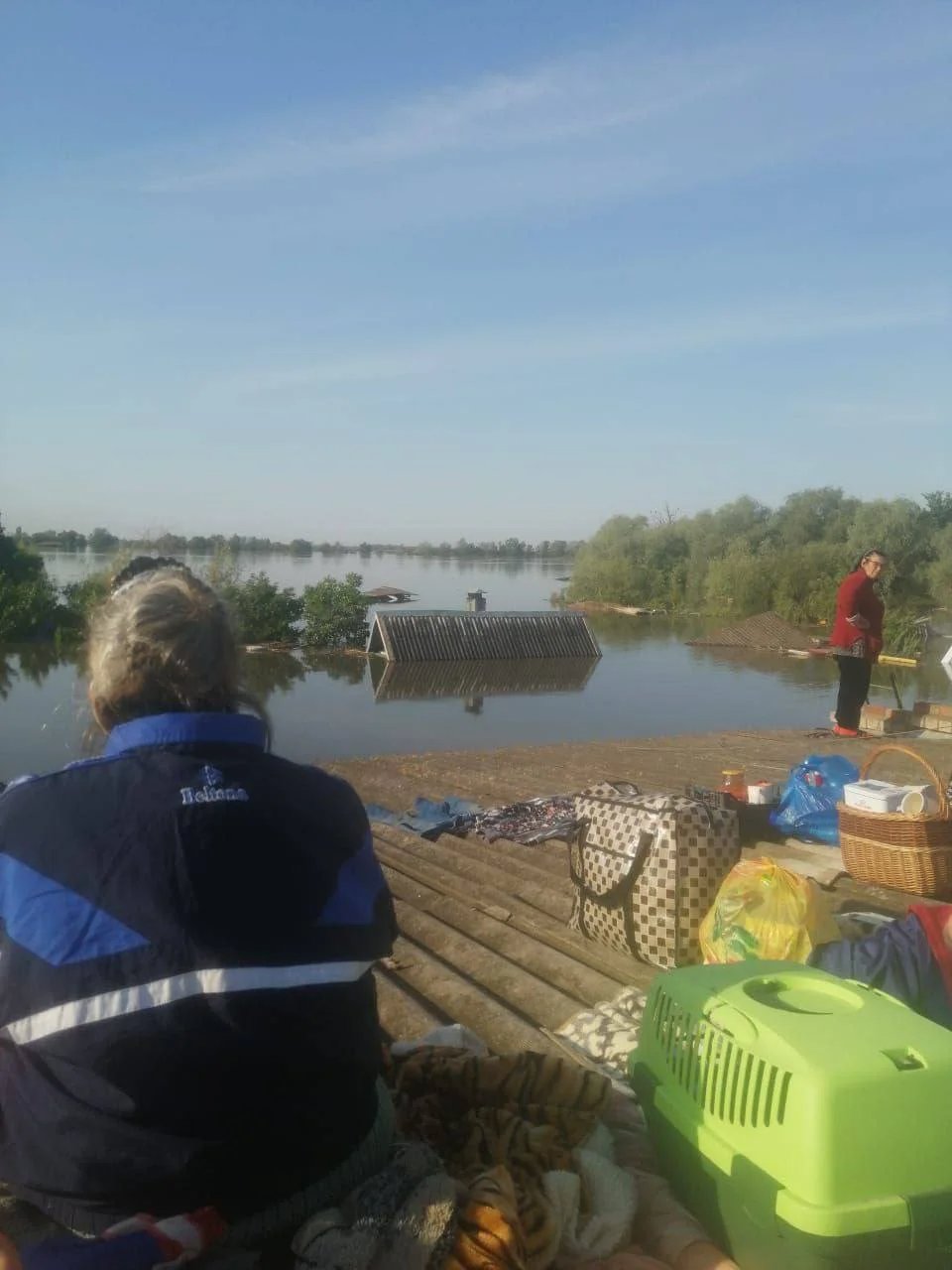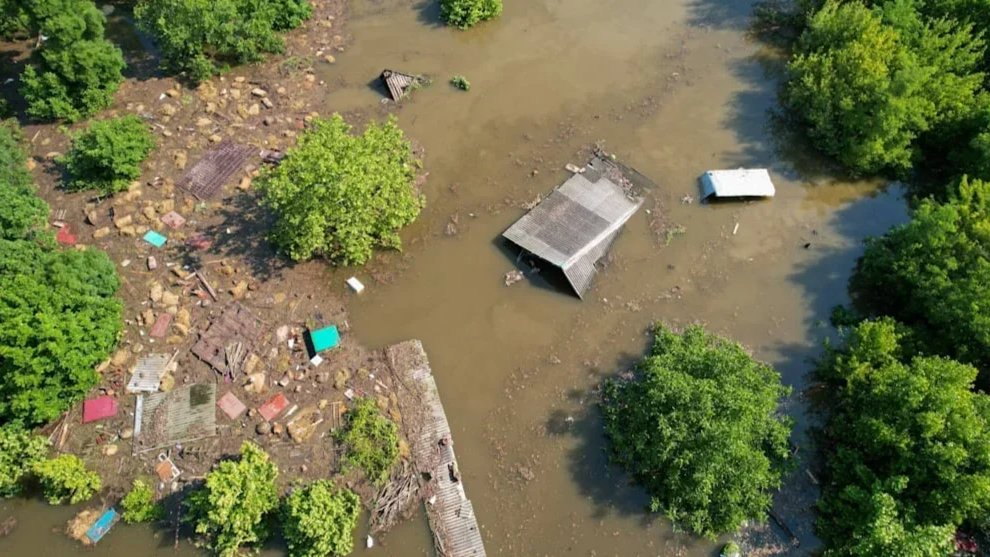Many residents of Nova Kakhovka and neighbouring communities on the left bank of the Dnipro River, occupied by Russia, are forced to climb on the roofs of their homes to escape the rising water. They complain that the occupation authorities, who call the territory Russian, did not start evacuating in time, and now people remain trapped in their homes. The situation is complicated because residents of coastal villages and Nova Kakhovka itself have no boats: the military commandeered them last year. There are no maps of the minefields either — they disappeared along with the military. Explosions can be heard intermittently in the flooded areas.
‘Because the Crimeans were getting worried’
The Kakhovka Hydroelectric Power Plant (HPP) dam collapsed on 6 June. According to locals, they heard a loud noise during the night that did not sound like usual explosions. Residents of coastal areas immediately realised what had happened and started to inform each other about the threat of flooding. Although the Russian-appointed “mayor” of Nova Kakhovka, Vladimir Leontyev, initially tried to reassure residents by saying that the dam was intact.
“There is no threat to the water supply of the North Crimean Canal (the Crimeans were getting worried),” he wrote early in the morning on the city administration’s official channel.
“Summer house settlements and Tsyurupinsk (former Soviet name of Oleshky — editor’s note) with Hola Prystan are being flooded. The maximum water rise level is 12 metres. There is no power or water in these settlements; the residents have left themselves. The water will come down in two-three days.”
The message appeared at 6:50 AM, although it was already known that the dam had collapsed by then, water had come into the city, and the water supply to the North Crimean Canal had ceased.
The Russian authorities’ official version has not changed: the Kremlin insists that Ukrainian artillery strikes broke the gate valves, after which an uncontrolled release of water began, and the dam gradually collapsed completely.
According to the Ukrainian side, the Russians blew up the dam from the inside in an attempt to stop an impending offensive by the Ukrainian Armed Forces.
Twenty minutes after the first report, Vladimir Leontyev said there was “no threat to people’s lives.”
“Emergency workers and authorities are controlling the water level in the river,” Leontyev said in a statement. “If necessary, we are ready to evacuate residents of coastal villages; buses have been prepared.”
Nova Kakhovka was built in the 1950s: the builders of the dam and the hydropower plant settled in the town. Before the war, it had about 44,000 inhabitants. In February 2022, Russian troops occupied Nova Kakhovka. The exact number of people who left the town is unknown.
Vessels commandeered
Local resident Yulia says that there are almost no children left in Nova Kakhovka: everyone who could have left the city, which has been under occupation for over a year.
“There used to be children’s camps here on the shore. It’s good that there’s no one there now. I don’t feel sorry for the military,” says Yulia.
According to her, there was absolutely no information about what was going on in the city for a long time.
“What to do? Where to run to? We packed up our things, our documents. Those who had upper floors or attics started to take household equipment and furniture there. In the morning, the electricity was out all over the city. The water was cut off too. Yes, yes, it sounds like a joke, but there is no water in the city,” says the young woman.
Other residents confirm that there was no organised evacuation of people.
The elderly and those who were bedridden were affected worst of all.
“A neighbour came running to us: her husband is paralysed. The house is one-storey, and the man was already in the water when we arrived. Thankfully, his wife had put some pillows high up for him while she was running for help.”
“She said that when she was leaving, the water was knee-deep. Again, how do we find help for an old person? Our younger neighbours, who had cars, left early in the morning. There was no one around. Had we come half an hour later, we wouldn’t have been able to help anymore,” says a man who helped carry out the sick person.
Instead of a stretcher, gardening tools and sheets had to be used. The paralysed man was carried to a nearby shed and dragged onto the roof.
“There are no boats!” the man says in outrage. “Last year, the military took all the boats from the local population! They called it ‘commandeering’. If we had boats, it would have been easier. But now…”
Yulia recounts what she saw in the first hours after the flooding:
“You can’t drive on the roads. People with belongings and pets walked along the washed-out roads knee-deep in water. We had to go about 5-7 km inland, away from the river: they say there were buses there, and someone was being taken out. But I don’t know anyone who got on these buses. Everyone organised on their own: some kind people took them.”
On his Telegram channel, Vladimir Leontyev reports that temporary accommodation facilities for residents of the Nova Kakhovka urban district have been opened in Henichesk and Skadovsk. By the evening of 6 June, he reported the evacuation of 1,300 people. Rescuers removed 17 people from rooftops, he said.
‘Help! People can’t swim!’
The town of Oleshky and the villages of Krynky and Korsunka were flooded almost completely. The residents had to move their belongings to the roof and spend the night there.
“Oleshky. The water is rising to the first floor, there are 12 people in the house, and elderly people. Help, please!” — a user called Hanna Kenzalo wrote on social media.

Residents of Oleshky. Photo courtesy of local residents
Boats are being collected across the region. Before the occupation, residents of coastal villages had them in abundance. Not anymore.
“Help! People can’t swim!” “People are sitting on the upper floor, and the water is coming in. There are three children, three old women, dogs and two men. Please help, as they only have one boat and not a lot of petrol,” residents of Oleshky continue calling for help two days after the dam collapse.
Volunteers load the rescue boats with drinking water and some food: they leave them for those they can’t pick up immediately.
Another problem is mines. According to residents of Nova Kakhovka, the Russian military has been mining coastal areas since last autumn. The flooding has covered the minefields; and no one knows where the minefields end — the military left the town on the first day. And their retreat was so sudden that residents saw soldiers sitting in trees waiting for backup in some places.
Locals say they regularly hear the sound of explosions. There is no mention of mines or explosions on the occupation authorities’ Telegram channel. Nor is there any mention that only holders of Russian passports receive evacuation assistance.
Several people at once have confirmed this information.
Nothing is known about any assistance to civilians by the Russian armed forces either. Vladimir Leontyev writes that Russia’s ruling party United Russia supplies the stranded people with drinking water.
“In Oleshky, the local authorities not only do not help with the evacuation, but on the contrary, they forbid people to leave the village,” says Yulia (It turned out later that these were people without Russian passports — editor’s note). “The volunteers are now gathering drones to look for people on the rooftops: many have dead phones and cannot send any information about themselves. But the military has warned that if they see the drones, they will shoot them down. They aren’t doing anything themselves and won’t let others.”
The occupation authorities, meanwhile, say they are ready to pay residents of Nova Kakhovka and neighbouring villages “10,000 (€113) and 50,000 (€567) rubles each, depending on the extent of the damage.”
As of noon on 7 June, the administration of the urban settlement is aware of 600 flooded houses, but this data, according to the officials themselves, needs to be clarified.
Authorities say evacuations by emergency workers are continuing and are sending encouraging messages to citizens that the water area is shrinking and the water levels are dropping — by 32 centimetres yesterday.
“However, water is arriving in downstream towns due to uncontrolled dumping. The evacuation mission continues,” reports the pro-government Nova Kakhovka Pravda Telegram channel.
‘They won’t let anything or anyone through at the checkpoint!’
We contacted volunteer Ekaterina Mikhailova: here is what she says about the situation in Oleshky.
“The town of Oleshky has been flooded completely. We mark the locations of people on the map. Each point is several people. We are now talking about hundreds who need immediate help. The problem is that people’s phones are running out of power, so communication with them gets interrupted.
We found paddlers from among the residents of Oleshky. We found the owners of the boats. We got them together. We organised the rescue for those we knew about. People were transported to the city centre, where there were still dry places, or taken to other, safer and more secure rooftops. But there is a critical need for more watercraft. Now we have purchased additional boats. The problem is how to get them to the site. Unfortunately, the checkpoints (Russian military checkpoints) do not allow anything or anyone at all. There is no information from the military.
In Oleshky itself, very few volunteers are willing to physically help. As a rule, they are locals. More volunteers are being sent there now from different regions of Russia. You cannot go from the right bank to the left bank of the Dnipro from Kherson now. We are not expecting help from there, unfortunately. People are ready to help, but they are not allowed. We have no direct contact with the local authorities. We don’t know what they are doing.
Another problem is with addresses: the streets in Oleshky have been renamed. Now it’s hard to find the correct addresses. We ask for geolocation, and we mark them on our maps. Some people do not sit on rooftops, where they can be seen, but in attics. This makes them hard to find.
There are a lot of elderly and sick people. Volunteers picked up a woman who weighed about 100 kg. There are also bedbound patients. They are technically difficult to move. I don’t know if they were able to help them. The emergency ministry, as far as I know, is trying to do something, but they are desperately short of resources.
Many people are with their pets. When it is possible, they take them out too. But not always.
At the moment, the water doesn’t seem to have risen any more. It is not known how many people have been rescued so far.”
With contributions by Alyona Itskova
Join us in rebuilding Novaya Gazeta Europe
The Russian government has banned independent media. We were forced to leave our country in order to keep doing our job, telling our readers about what is going on Russia, Ukraine and Europe.
We will continue fighting against warfare and dictatorship. We believe that freedom of speech is the most efficient antidote against tyranny. Support us financially to help us fight for peace and freedom.
By clicking the Support button, you agree to the processing of your personal data.
To cancel a regular donation, please write to [email protected]

